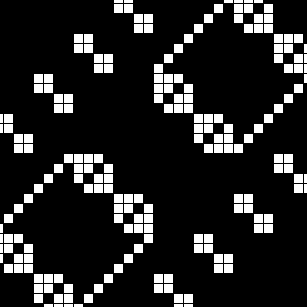Based on: Untitled 2 by Vladimir Bonacic, 1977
Category: experimental
Description:
This sketch does not run in the browser.

/*
Part of the ReCode Project (http://recodeproject.com)
Based on "Untitled 2" by Vladimir Bonacic
Originally published in "Computer Graphics and Art" vol2 no3, 1977
Copyright (c) 2012 Martin Schneider - OSI/MIT license (http://recodeproject/license).
*/
////////////////////////////////////////////////////////////////////////
// //
// "Dynamic Object GF.E (16, 4) 69/71" by Vladimir Bonačić //
// //
// (interactive version) //
// //
////////////////////////////////////////////////////////////////////////
// The dynamic object is a 32 x 32 display.
// It visualizes objects from abstract algebra,
// which are known as Galois groups.
// Source:
// "Research and Teaching in Art and Science" by Vladimir Bonačić
// Computer Graphics and Art Vol. 2, No. 3 pp. 4-8
// See also:
// "Kinetic Art: Application of Abstract Algebra to Objects with Computer-
// Controlled Flashing Lights and Sound Combinations" by Vladimir Bonačić
// Leonardo, Vol. 7, No. 3
// Note: This paper is quite mathematical at times.
// The implementation however is actually really simple.
///////////////////////// INTERACTIVE VERSION ///////////////////////////
// This is the dynamic interactive version with pattern cycling and
// mouse interaction ( the original had 32 keys to control the pattern )
// - press space to toggle animation
// - press 'p' to switch through presets
// - press 'g' to toggle afterglow
// - use the mouse to modify the pattern
////////////////////////////////////////////////////////////////////////
int d = 1<<5; // cells per dimension
int led = 10; // size of the light bulb
int w = led * d + 1; // display size
int pick = 1; // picked preset
// we need the long datatype, because we have 32 bit positive integers
long[] preset= { 4294967295l, 100675584l, 2146959392l, 4293918847l };
// there are 2^32 different patterns controlled by the 32 bits of p
long p = preset[pick];
// the generator is used to create a more interesting pattern sequence
long generator = 4299161607l;
int frames = 60;
boolean animate = true;
boolean debug = true;
boolean glow = true;
void setup() {
size(w, w);
info();
}
void draw() {
// add some afterglow
fill(0, glow ? 30 : 255); rect(0, 0, w, w); fill(255);
// draw the pattern
for(int y = 0; y < d; y++) {
for(int x = 0; x < d; x++) {
// this is where the magic happens
if( (1l<<(x ^ y) & p ) > 0) {
rect(led * x, led * y, led, led);
}
}
}
// jump to a different pattern
if( animate && frameCount % frames == 0) {
p *= 2;
if(p >= 1l<<d) p ^= generator;
info();
}
// change the pattern using the mouse
if(mousePressed) {
int x = (mouseX/led) & d-1;
int y = (mouseY/led) & d-1;
long bit = 1l<<(x ^ y);
p = mouseButton == LEFT ? p | bit : p & ~bit;
info();
}
}
void keyPressed() {
switch(key) {
// animation on/off
case ' ': animate = ! animate; return;
// switch between presets
case 'p': p = preset[pick = (pick + 1) % preset.length]; animate = false; break;
// next pattern
case '+': p++; break;
// previous pattern
case '-': p--; break;
// toggle afterglow
case 'g': glow = !glow; break;
// toggle debugging
case 'd': debug = !debug;
default: return;
}
// constrain to 32 bits
p &= ((1l<<d) - 1) ;
info();
}
// show pattern input
void info() {
if(debug) println("p = [" + binary((int) + p, d)+ "] = " + p );
}